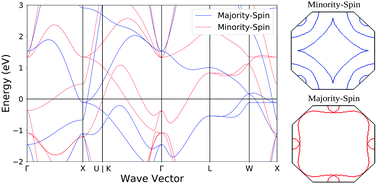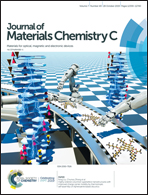Unconventional superconductivity in 3d rocksalt transition metal carbides†
Abstract
Through calculation and analysis of electronic structure and lattice dynamics in 3d transition metal carbides, we identify MnC as a novel compound displaying unconventional superconductivity. Though unstable in the absence of applied pressure at 0 K, MnC may be stabilized above 300 K or 13 GPa due to enhanced t2g orbital overlap or phonon–phonon interactions respectively. In the resulting structure, which adopts a ferromagnetic configuration with magnetization of 1.55 μB per Mn, we predict superconductivity occurring below a critical temperature of 16.2 K. Further investigation reveals this unconventional superconductivity derives from phonon-mediated minority-spin-triplet Cooper pairs, for which competing magnetic order is also suggested to play a role. Consideration of all 3d transition metal carbides yields a holistic explanation of trends in stability and superconductivity. Two unique cases are predicted: (i) FeC, with a critical temperature of 4.0 K, may be stabilized by temperature or pressure, whereas (ii) ZnC, with a high critical temperature of 27.8 K, remains stable at 0 K owing to complete filling and strong localization of its 3d shell. The findings here contribute to the understanding of factors influencing superconductivity, hence forming a basis on which a materials-by-design approach may be utilized for next-generation applications such as spintronic devices.



 Please wait while we load your content...
Please wait while we load your content...